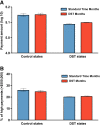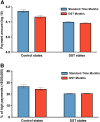Medical malpractice litigation and daylight saving time
- PMID: 38445709
- PMCID: PMC11145060
- DOI: 10.5664/jcsm.11038
Medical malpractice litigation and daylight saving time
Abstract
Study objectives: Daylight saving time (DST) constitutes a natural quasi-experiment to examine the influence of mild sleep loss and circadian misalignment. We investigated the acute effects of spring transition into DST and the chronic effects of DST (compared to standard time) on medical malpractice claims in the United States over 3 decades.
Methods: We analyzed 288,432 malpractice claims from the National Practitioner Data Bank. To investigate the acute effects of spring DST transition, we compared medical malpractice incidents/decisions 1 week before spring DST transition, 1 week following spring DST transition, and the rest of the year. To investigate the chronic effects of DST months, we compared medical malpractice incidents/decisions averaged across the 7-8 months of DST vs the 4-5 months of standard time.
Results: With regard to acute effects, spring DST transitions were significantly associated with higher payment decisions but not associated with the severity of medical incidents. With regard to chronic effects, the 7-8 DST months were associated with higher average payments and worse severity of incidents than the 4-5 standard time months.
Conclusions: The mild sleep loss and circadian misalignment associated with DST may influence the incidence of medical errors and decisions on medical malpractice payments both acutely and chronically.
Citation: Gao C, Lage C, Scullin MK. Medical malpractice litigation and daylight saving time. J Clin Sleep Med. 2024;20(6):933-940.
Keywords: cognition; emotional reactivity; health care policy; medical errors; performance; sleep deprivation.
© 2024 American Academy of Sleep Medicine.
Conflict of interest statement
M.K.S. was supported by the National Science Foundation (1920730, 1943323) and National Institutes of Health (AG05316). C.G. was supported by the Alzheimer’s Association (AARFD-22-928372), the American Academy of Sleep Medicine Foundation (290-FP-22), the BrightFocus Foundation (A2020886S), and the National Institute on Aging (RF1AG059867).
Figures





References
-
- Kane L , Shute D . Medscape Malpractice Report 2019. https://www.medscape.com/slideshow/2019-malpractice-report-6012303 . Accessed March 15, 2024.
-
- Saitta N , Hodge SD Jr . Efficacy of a physician’s words of empathy: an overview of state apology laws . J Am Osteopath Assoc. 2012. ; 112 ( 5 ): 302 – 306 . - PubMed
-
- Ben Simon E , Vallat R , Barnes CM , Walker MP . Sleep loss and the socio-emotional brain . Trends Cogn Sci. 2020. ; 24 ( 6 ): 435 – 450 . - PubMed
-
- Tempesta D , Salfi F , De Gennaro L , Ferrara M . The impact of five nights of sleep restriction on emotional reactivity . J Sleep Res. 2020. ; 29 ( 5 ): e13022 . - PubMed
-
- Anderson C , Dickinson DL . Bargaining and trust: the effects of 36-h total sleep deprivation on socially interactive decisions . J Sleep Res. 2010. ; 19 ( 1 Pt I ): 54 – 63 . - PubMed
MeSH terms
LinkOut - more resources
Full Text Sources

